
PREV ARTICLE
NEXT ARTICLE
FULL ISSUE
PREV FULL ISSUE
SELECTIONS FROM THE STACKS-BOWERS FEBRUARY 2016 RARITIES SALE
Here are some lots that caught my eye in the upcoming Stack's Bowers rarities Sale. -Editor
Lot 27: Haiti Bernard Kock 20 Dollars Note

Exceedingly Rare and Enigmatic Bernard Kock 20 Dollars Note From an American Government-Supported Freed Slave Settlement Series Island of A’Vache, Port St. Minna, Haiti, West Indies. Bernard Kock, Lessee of the Island. Jan. 1, 1863. 20 Haitian Dollars/Vignt Gourdes. PCGS Choice About New 58 Apparent. Lithographic Proof. (Unlisted in the Standard Catalog of World Paper Money). An exceedingly rare and historic American possession rarity with an amazing background that is virtually unknown to United States collectors. Prepared by Arthur, Gregory & Co., Engr. New-York as a lithographic proof on thick paper, a deeply inked impression. Bi-lingual, French and English texts flank top center vignette of African-American field hand picking cotton bisecting issuer BERNARD KOCK. At base, emblem and scroll REPUBLIQUE DE HAITI. Engraved signature of Bernard Kock as superintendent. The freed slave settlement of Island A’Vache or Cow Island, off the coast of Haiti, is a footnote story in American history that might fill a small a book. It is a key chapter in several re-colonization movements related to the American Abolitionist movement because it happened during the Civil War, on the cusp of the Emancipation Proclamation. Briefly, Mr. Kock, with good intentions, formed his company to settle freed blacks to work on the cotton plantations (the cotton grown there was of high quality, coveted by English manufacturers who were short supplied during the Union blockade of Confederate ports) with those workers eventually being able to become Haitian citizens and landholders. This plan had the support of investors, as well as the United States and Haiti governments. However, during the emigration and settlement, disorganization and turmoil ensued including a lack of provisions, and eventually rebellion broke out among workers. This chaos placed the State Department and even President Lincoln, who had recently signed his Emancipation Proclamation, in an unfavorable light. The United States did send support in December 1863 and repatriated settlers. The notes themselves were only used at the company store and we record only three examples, all different denominations, offered publicly. To read the complete lot description, see:
Lot 62: Member Badge of the Tammany Society or Columbian Order.
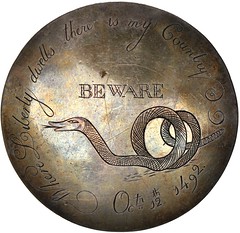 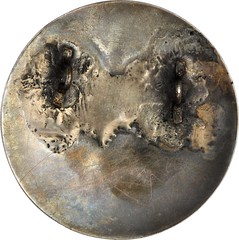
(Circa 1790-1820) Member Badge of the Tammany Society or Columbian Order. Silver, engraved. 67.8 mm. 41.2 grams. Choice Extremely Fine or better. Carefully engraved and beautifully toned in golden gray with variegated highlights, this is among the most attractive examples of this historic early American badge. The obverse is neatly hand-engraved, showing some light hairlines and a few minor and well-aged scratches. A scrape is seen above the letters OU of COUNTRY. The body of the badge is convex, as made and like most seen, with the unengraved reverse showing heavy solder anchoring two bent silver loops. A ribbon would have been passed through these loops to allow for display on the owner's lapel. The quality of the engraving and the overall aesthetic appeal are excellent. Founded as a fraternal organization in the wake of the American Revolution, theTammany Society idolized two figures. One was the Lenni-Lenape chief Tamenend, who was described by William Penn in the language of the noble savage. Recounting Tamenend's virtues in 1817, the Native American missionary John Heckewelder wrote, "In the Revolutionary war, his enthusiastic admirers dubbed him a saint, and he was established under the name of St. Tammany, the Patron Saint of America." The other character idolized by the Tammany Society was Christopher Columbus, "the founder of America," giving the organization a distinctly American, even nativist, outlook. As the fraternity got its footing in the 1790s, its membership developed a certain level of socio-economic and political homogeneity: middle class, anti-Federalist, largely composed of urban veterans. It occupied the opposite end of the political continuum from the pro-Federalist Washington Benevolent Society, which was strongest in New York, though chapters existed in most American cities. The Tammany Society's opposition to the Society of the Cincinnati was socio-economic as well as political, populist in voice and fearful of the aristocratic pretensions of the Cincinnati, a group composed of Revolutionary War officers and their oldest sons. The Tammany Society would eventually become known exclusively for its politics, evolving into the Tammany Hall machine that defined American political cronyism for generations. All of the members badges feature the same design: a coiled rattlesnake with 13 rattles, the word BEWARE in the field above, the legend WHERE LIBERTY DWELLS, THERE IS MY COUNTRY around the circumference, with OCTOBER 12TH, 1492, the date of Columbus' arrival, below. Several of the known badges are clearly made by the same hands. This example is a near twin to the example in the collection of the New-York Historical Society, while the example offered in our (Stack's) September 2009 Americana Sale appears to have been engraved by the same hand as one of the examples in the Rhode Island Historical Society. None of the badges are marked, though Vicken Yegparian has made a persuasive case for several originating in Rhode Island. Of the 12 known examples, four have been in Rhode Island institutions for over a century. Others are included in the William Sumner Appleton Collection at the Massachusetts Historical Society and the New-York Historical Society, leaving just six more in private hands. Four have been sold in major auctions in the last decade, an unusual convergence: the example in the 2006 Bonham's sale of the lifelong collection of William H. Guthman (sold for $18,720), the aforementioned example in our (Stack's) September 2009 sale (sold for $12,650), the bent example that first appeared in our (Stack's) May 2008 Minot Collection Sale (at $10,350), and this one. The badges of the Tammany Society or Columbian Order are little known, though they have been included in numismatic cabinets dating back to the Civil War. To read the complete lot description, see:
Lot 70: U.S. Mint Retirement Medal
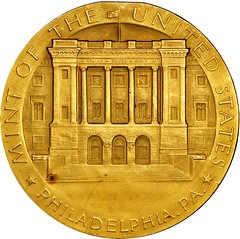 
"1899-1941" U.S. Mint Retirement Medal. Gold. 50.6 mm 91.2 grams. Choice About Uncirculated. This rare medal is 50.6 mm, 1,407.43 grains, and features a view of the front entrance to the third Philadelphia Mint building (1901-1969). Inscription MINT OF THE UNITED STATES / PHILADELPHIA around, signed A. PIETZ at the bottom. This is the same die used on the 1934 Assay Commission medal. The reverse is a specially prepared die, unsigned, with a laurel wreath surrounding the struck-up legend TO / H. DUDLEY / COLEMAN / FROM HIS ASSOCIATES / IN THE UNITED STATES MINT / IN / SINCERE APPRECIATION / OF HIS LONG / AND DISTINGUISHED / SERVICE / JUNE 17 1899 / OCTOBER 21 1941. Matte gold finish in choice About Uncirculated condition with a noticeable edge bump at 12 o'clock. Housed in a burgundy leather and cream velour presentation case. Once offered as being awarded to Hamilton Dudley Coleman, a New Orleans businessman and politician, who acted as "melter and refiner" at the New Orleans Mint from 1899 to 1905, was an Assay Commission Member in 1912, and died in 1926. However, the dates on the medal do not completely fit this attribution. Perhaps issued to a family member also employed by the Mint. Regardless, this is truly a one-of-a-kind medal worthy of further research. Adam Pietz is also well remembered as the designer of the 1946 Iowa Centennial commemorative half dollar. To read the complete lot description, see:
Lot 116: 1877 Liberty Seated Quarter
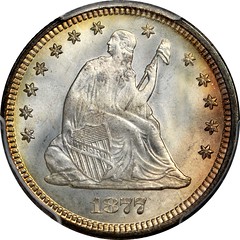 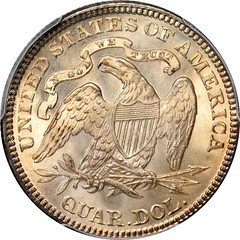
This remarkable Superb Gem needs to be seen to be fully appreciated. Highly lustrous and satin surfaces are adorned with lovely champagne-gold iridescence. The toning is evenly distributed over the reverse, although confined to the periphery on the obverse. Boldly struck throughout and absolutely pristine in virtually all areas. Although the mintage was generous, Larry Briggs offered a word of caution in his 1991 reference The Comprehensive Encyclopedia of United States Liberty Seated Quarters: "Even though common, not seen as often as one would think. Many likely on hand and melted for new silver dollar [coinage] of 1878." To read the complete lot description, see:
Lot 215: 1877 Liberty Half Eagle
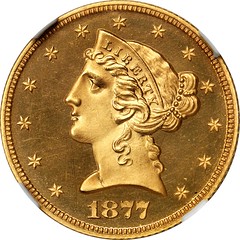 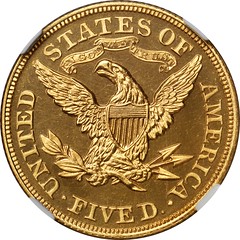
1877 Liberty Half Eagle. Proof-65 Cameo (NGC). Pale golden surfaces display bold cameo contrast between frosty devices and polished fields. Under closer inspection, light hairlines can be seen when tilted and rotated in a light. One such line on the cheek serves to identify this specimen for provenance purposes, as do a pair of minor carbon flecks near star 13. Boldly struck throughout with only a hint of weakness at the absolute highest points of the design. This is a spectacular Gem Cameo survivor from a minuscule mintage of just 20 pieces. Jeff Garrett and Ron Guth opine that less than half of that number exist today. In the 2008 edition of their reference Encyclopedia of U.S. Gold Coins: 1795-1933, the authors state that "during the course of the last 15 years, there have only been three coins offered at public auction." To read the complete lot description, see:

Wayne Homren, Editor The Numismatic Bibliomania Society is a non-profit organization promoting numismatic literature. See our web site at coinbooks.org. To submit items for publication in The E-Sylum, write to the Editor at this address: whomren@gmail.com To subscribe go to: https://my.binhost.com/lists/listinfo/esylum All Rights Reserved. NBS Home Page Contact the NBS webmaster 
|